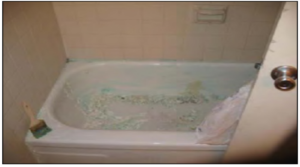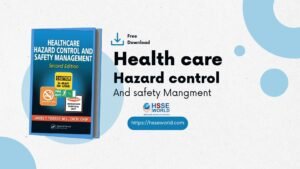A Bathtub Refinisher Dies from Methylene Chloride Exposure :Safety Flash
3 min readA bathtub refinisher, working alone in a small apartment bathroom, died of methylene chloride exposure while using the chemical to remove paint from a bathtub. The bathroom had a small, open window but no mechanical ventilation. The victim was not wearing any respiratory protection. The victim was the sole employee of a company that specialized in refinishing bathtubs and sinks. The California Fatality Assessment and Control Evaluation (CA/FACE) Program concluded that bathtub refinishing contractors should take the following steps to prevent similar incidents:
- Use a safer paint removal product such those containing benzyl alcohol, dimethylglutarate, or dimethyl adipate. Avoid using products that contain methylene chloride or n-methyl pyrrolidone (NMP).
- If a methylene chloride-containing paint remover is used, it should only be done in a wellventilated bathroom, using an airline respirator and polyvinyl alcohol (PVA) or Silvershield® gloves.
These flashes summarize the key matters and incidents, allowing wider dissemination of lessons learnt form them. The information below has been provided in a good faith by members and should be reviewed individually by recipients, who will determine it’s relevance to their own operations.
incident summery
Case report: #17CA002
Issued by: California Fatality Assessment and Control Evaluation (FACE) Program
Date of incident: June 23,2017
A 43-year-old bathtub refinisher, working alone in a small apartment bathroom, died from exposure to methylene chloride. The w orker had been using a methylene chloride-containing paint remover. The bathroom had a small, open window but no mechanical ventilation. The victim was not wearing respiratory protection. The business owner reported that he had personally trained the victim, and had established safety rules that were to be followed. He reported that he told the victim to always use gloves, goggles and a respirator, and to have good ventilation. However, he did not have a written Injury and Illness Prevention Program.
orker had been using a methylene chloride-containing paint remover. The bathroom had a small, open window but no mechanical ventilation. The victim was not wearing respiratory protection. The business owner reported that he had personally trained the victim, and had established safety rules that were to be followed. He reported that he told the victim to always use gloves, goggles and a respirator, and to have good ventilation. However, he did not have a written Injury and Illness Prevention Program.
The employer was the victim’s brother-in-law and they lived together in the same house. The brother-in-law ran a small company specializing in the refinishing of bathtubs, sinks, His primary language was Spanish, but he also spoke limited English. He had been doing this type of work for 20 years. The employer was not a licensed contractor, but he had incorporated as a business the year before. At the time of the incident, the victim was his sole employee. The company could handle two jobs at a time, with the owner and the victim each working alone. If there was just one job scheduled, the victim would do the work. The owner reported that they completed about five to six jobs per week. Property owners usually choose to refinish a bathtub, since replacing a tub is more costly.
To prevent future occurrences:
To prevent future occurrences:
- Use a safer paint removal product such as those containing benzyl alcohol, dimethylglutarate or dimethyl adipate. Avoid using products that contain methylene chloride or n-methyl pyrrolidone. Methylene chloride enters the body when inhaled and can be absorbed through unprotected skin. It can immediately irritate the eyes, nose and throat. Direct contact can cause severe burns to the skin and eyes. Even small exposures are harmful over time as they can damage the liver, kidneys and nerves, and can cause cancer.
- If a methylene chloride-containing paint remover is used, it should be applied only in a well-ventilated space, using an airline respirator and polyvinyl alcohol or Silvershield gloves. To reduce the buildup of toxic vapors, a continuous flow of clean air to the work area is needed, and a protective respirator must be worn.



